Thermal Pulses
-
Making C-12
- We have seen how the thermal pulses produce C-12, and how the following dredge-up then mixes this to the surface. This is the simplest and perhaps the most important of the nucleosynthesis occurring in AGB stars! But there is much more happening, which we discuss here also.
- On the observational side, we recall that most stars have more O-16 than C-12. But repeated thermal pulses preferentially add C-12 to the surface, so that eventually, if the third dredge-up continues, we can have the C-12 atoms outnumbering the O-16. We then have what is known as "Carbon Star". These are indeed observed, on the AGB, at the higher luminosities, indicating that they have experienced many thermal pulses prior to their reaching Carbon Star status. There are still some lingering doubts about the making Carbon stars of the lowest luminosities observed, however.
-
Neutron Captures: the s-process
- AGB stars are observed to produce large enhancements of certain neutron-rich species. The particular ones seen in AGB stars are the so-called "s-process elements" meaning that they formed in an environment where neutron capture was a slow (hence the s) process compared to beta-decay. But how do these stars make these elements?
- The crucial thing here is the interaction between two pulses.
After a dredge-up episode, it seems that sometimes one finds some H partially
mixed downward into the intershell region, which is rich in He-4 and C-12.
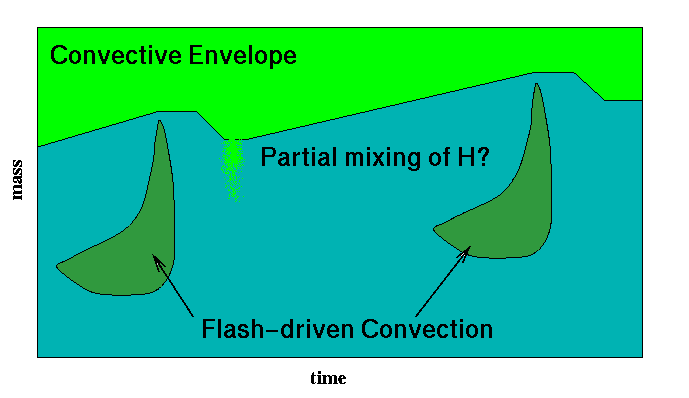
- This partially mixed region can come about as a result of some convective overshooting, some semiconvection, or perhaps shear instabilities due to rotation. We do not know the details, sadly! But it certainly seems to get there.
- Once the H exists in this region, it combines with C-12 to make
C-13 during the next interpulse, when the star contracts again, and heats.
C-13 is
a very good neutron source:

- This during the interpulse phase, when the star contracts, the
C-13 captures the abundance He-4 nuclei to produce neutrons. These are then
captured on Fe and other heavy elements, to produce the s-process elements.
This is outlined, schematically, in the following
movie which shows how these nuclides then get dredged to the surface at
the next pulse.
- This movie shows a quantitative calculation. The C-13 profile was inserted by hand, however. But you can see the C-13 burning and releasing neutrons (watch the bottom of the screen!) and these neutrons are captured on heavy elements, represented here by the element "g" which counts the neutron captures beyond Fe. Convective regions are shown cross-hatched, When the next pulse occurs it mixes in regions with more C-13, giving another brief burst of neutrons.
- Did you notice that at the end of the pulse, when the temperature in the intershell convective zone reaches its highest values, there is a second burst of neutrons> these come from Ne-22. But where did the Ne-22 come from?
- As the H-shell advances outward it burns by the CNO cycles. Thus
essentially all C, N and O get turned into N-14. Then during a pulse:
 And finally, the Ne-22 release neutrons via:
And finally, the Ne-22 release neutrons via: -
Making F-19
- AGB stars are also believed to be prime sources of F-19. Observationally there is a clear correlation between F/O and C/O. Since the latter derives from thermal pulses, we expect the former will also. But how?
- The beginning of F-19 production is the same as for C-13. We need some H mixed into the intershell region. But we also will need some protons, which can come from (n,p) reactions on N-14 and Al-26, mostly. The schematic movie shows the F-19 production mechanism, through the production of N-15. The main problems are that some of the reactions can occur in the intershell region, and some can occur in the convective shell itself. And F-19 is easily destroyed, too! Its a complicated story: see the various papers by Nami Mowlawi to get the story straight!
- Here is a schematic summary of the F-19 production
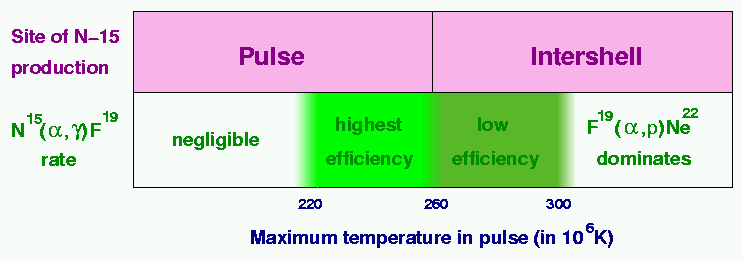
- And here is a movie showing the production of the protons via the (n,p) reactions on N-14 and Al-26. Watch the protons track the neutrons, which are produced by the C-13 + He-4 reaction. So where C-13 is destroyed we see n and p. These are also correlated with the C-14 and Mg-26 production from the (n,p) reactions.
- To help explain this further, here are the rates at the bottom and the top of the intershell convective zone. Note that in these plots the thickest yellowest lines re the fastest reactions, scaling (through many orders of magnitude!) to the thin red lines.
- And here is the whole thing showing the production of F19, via O18 and M15 production, as discussed above.
- And here is the surface value of F-19. Note how it is produced and then destroyed again. This is because F-19 is easily destroyed by HBB. NO doubt about it, the case of F-19 is complicated....
-
Ne, Na, Mg, Al....
- We have seen how these stars can produce Ne-22. But this Ne-22
is also a source for further reactions, if the temperature on the
intershell region is hot enough:
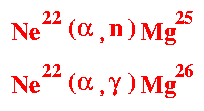
- Then, during dredge-up, these isotopes of Mg are mixed to the surface. Dramatically non-solar abundances can result from this process!
- The rates figures mentioned above also show the production of the Mg isotopes
- The next movie shows the production of the Mg isotopes during a thermal pulse.
- Also, any Ne-22 that is not destroyed and is dredged to the envelope can then be processed by the H-shell into Na-23.
- Likewise, and Mg-25 or Mg-26 in the envelope can be processed to Al-26 and Al-27 (respectively) by proton captures in the H-shell. Although a reasonable amount of Al-26 can be produced in this way, Al-26 is quite a strong neutron poison, so that at the next pulse it is destroyed via (n,p) reactions (the same ones needed to make protons for F-19....) This is shown in the following movie.

Hot Bottom Burning
- And to make matters even more complicated, if the mass of the star is sufficiently high (about 4 or 5 Msun at solar composition, but decreasing as the metallicity decreases) the bottom of the deep convective envelope actually penetrates the top of the H-shell. Hence nucleosynthesis occurs at the bottom of the convective envelope itself. This is known as "Hot Bottom Burning".
- Here is the time dependence of the temperature at the bottom of the convective envelope of out 5Msun model. Note that values near 10^8K are reached!
-
Li Production
- The first thing to happen is that Li-7 is produced via the
Cameron-Fowler Beryllium Transport Mechanism. This is basically P chains plus
convection! The idea being to start the pp chains, to make Be-7 (see below)
and then to use convection to move the Be-7 away from the hot region before
it can complete the PPII or PPIII chains.

- Below is a snap-shot of the production of Li in the envelope.
We have an upward moving convective stream and a downward moving stream.
The upward stream is rich in Be-7, since it has just been produced at the
bottom of the convective envelope. The Be-7 is then taking to cooler
temperature where it captures an electron to form Li-7. Hence the downward
stream is relatively rich in Li-7, but it does mix it down to high
temperature where it suffers destruction to some extent. Hence the Li
production is limited by how much He-3 is present initially: once it is
all used up then the Li-7 will eventually decline again.
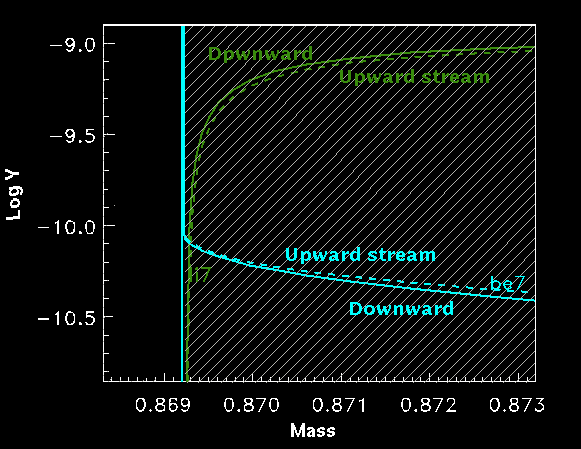
- Below we see the time dependence of the surface Li abundance. Indeed the super-Li-rich phase is temporary....
- But notice that the observed abundances, shown here in blue, match very well the models!
-
CNO Cycling
- Of course, Hot Bottom Burning does other things too. For a start,
it will be burning H via the CN cycles. This will t urn C-12 into C-13
and N-14.
But we are adding C-12 at each pulse. This is what makes a Carbon star.
But if HBB is active, then the added C-12 can be burned into N-14 and the
star will
not become a carbon star after all!
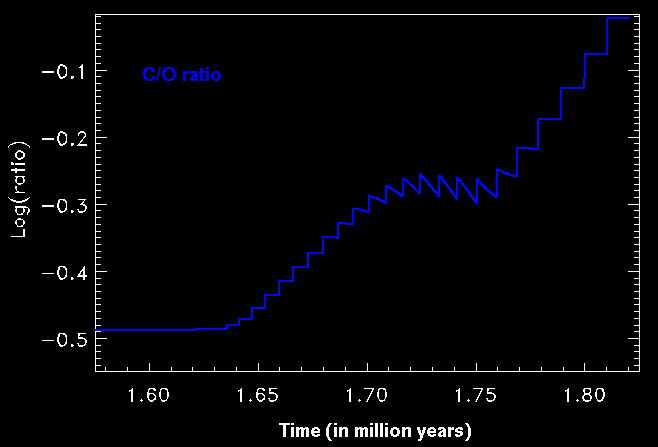 Here we see the C/O ratio decreasing once the HBB starts!
Here we see the C/O ratio decreasing once the HBB starts! - Here are some plots for M=4, 5 and 6 Msun each with Z=0.02
(solar), Z=0.008 (Large Magellanic Cloud) and Z=0.004 (Small Magellanic
Cloud).
- C/O plot showing that HBB prevents the occurrence of C stars. In fact, however, once the mass-loss gets going and the envelope mass is decreased substantially, then the HBB ceases and the dredge-up continues. So sometimes a C-star can still form, albeit briefly and at the end of the star's life (when it is not visible because of the lost mass obscuring it from view). The diagram has the region corresponding to C stars (C/O > 1) shown in magenta.
- C-12/C-13 plot showing equilibrium values when HBB dominates.
- N-14 plot showing lots of N-14 made when HBB exists.
-
Ne-Na and Mg-Al Cycles
- And it doesn't stop there. At these high temperatures we also
have activation of the Ne-Na and Mg-Al cycles, as shown below. Note that
these cycles affect the production of these elements in addition to
their production and destruction in the He shell, and subsequent dredge-up.
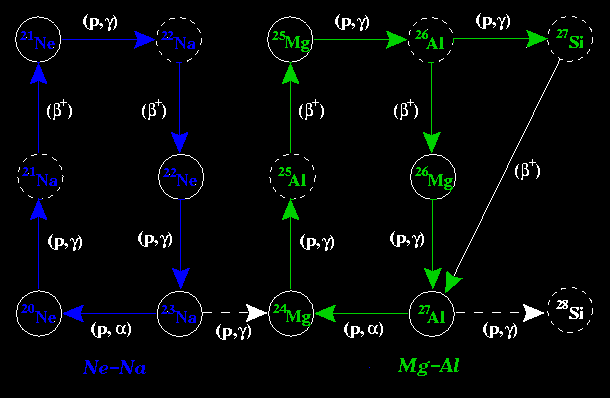
- And this movie, although rather complicated, shows the production of Ne, Na, Mg and Al both through dredge-up as well as HBB.
- We have seen how Mg25 ad Mg26 are made by the He shell, and then
dredged to the surface. Here HBB can produce Al26 and Al27, respectively.
This is visible in the previous movie, and the surface Al26 abundance is
shown below.
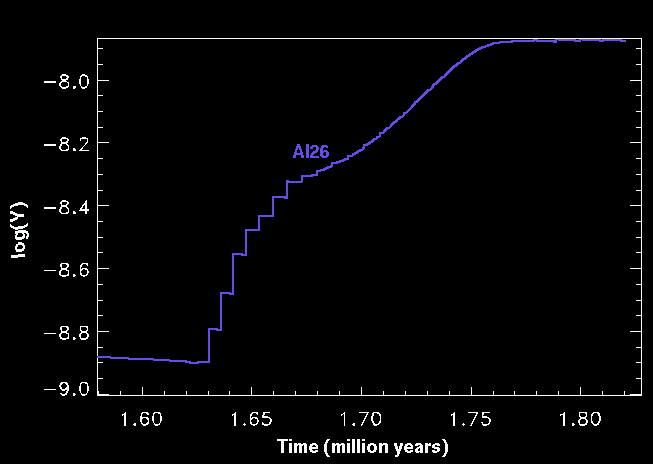
- Here are the Mg and Al isotopic ratios for the 9 cases we have
looked at earlier (M=4, 5 and 6, Z=0.004, 0.008 and 0.02).
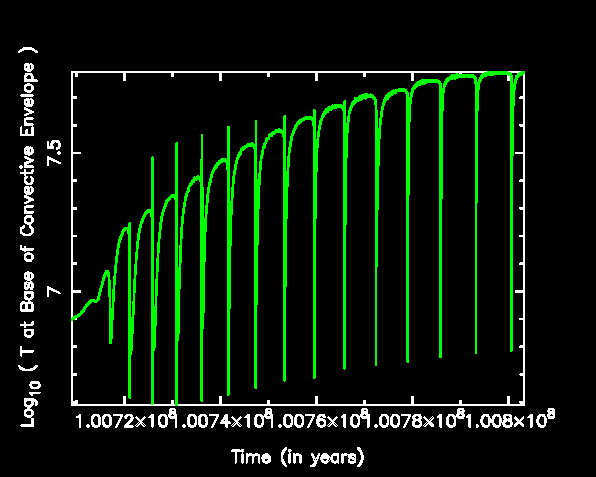
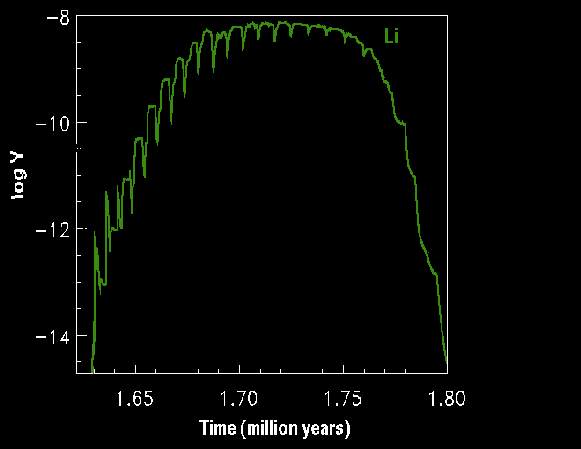
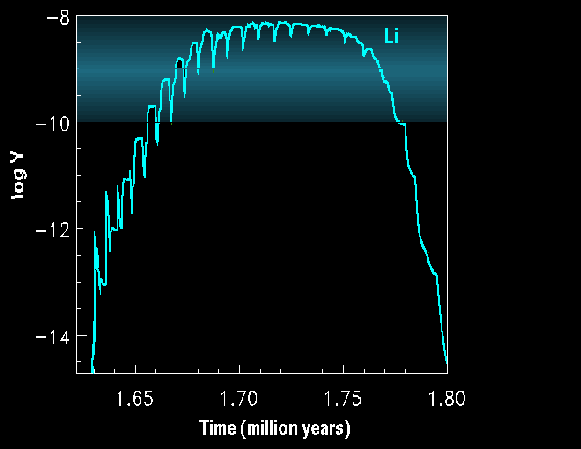
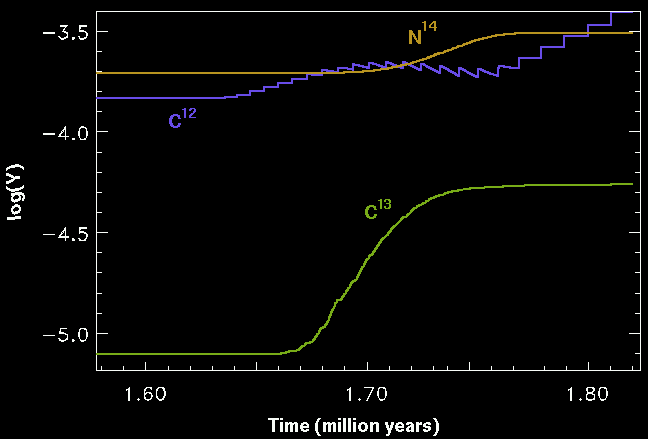
The C13 content increases with the C12 abundance, due to the processing of C12 into C13. In extreme cases, when the entire envelope can be processed many time between the pulses, then HBB can produce the equilibrium ratio of C12/C13 about 3.5. And a consequence of this burning is the copious production of primary N-14.
Summary
- This brief survey has been designed to illustrate the principles of nucleosynthesis (and AGB evolution). The details are quite another matter, of course. Remember that there are enormous variations with the stellar mass and also composition. What's more, there are many uncertainties, from the treatment of dredge-up, the neglect of overshoot (or even how to include it properly!), rotation (of course) and reaction rates.
- So hopefully this has helped explain! But if you want quantitative estimates, things get harder. Better contact me!